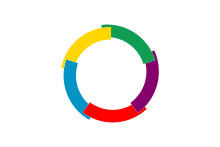Burkina Faso
| Burkina Faso |
||||||
|---|---|---|---|---|---|---|
|
||||||
| Motto: "Unité–Progrès–Justice" (French) "Unity–Progress–Justice" |
||||||
| Anthem: Une Seule Nuit / Ditanyè (French) One Single Night / Hymn of Victory |
||||||
![Location of Burkina Faso (dark blue)– in Africa (light blue & dark grey)– in the African Union (light blue) – [Legend]](../I/m/Location_Burkina_Faso_AU_Africa.svg.png) Location of Burkina Faso (dark blue) – in Africa (light blue & dark grey) |
||||||
| Capital and largest city | Ouagadougou 12°20′N 1°40′W / 12.333°N 1.667°W | |||||
| Official languages | French | |||||
| Recognised regional languages | Mòoré Mandinka Bambara |
|||||
| Ethnic groups (1995) | ||||||
| Religion | Islam Christianity Animism |
|||||
| Demonym |
|
|||||
| Government | Semi-presidential republic | |||||
| - | Acting President | Michel Kafando | ||||
| - | Acting Prime Minister | Yacouba Isaac Zida | ||||
| Independence | ||||||
| - | from France | 5 August 1960 | ||||
| Area | ||||||
| - | Total | 274,200 km2 (74th) 105,869 sq mi |
||||
| - | Water (%) | 0.146% | ||||
| Population | ||||||
| - | 2014 estimate | 17,322,796[1] (61st) | ||||
| - | 2006 census | 14,017,262 | ||||
| - | Density | 57.4/km2 (145th) 148.9/sq mi |
||||
| GDP (PPP) | 2014 estimate | |||||
| - | Total | $28 billion[2] | ||||
| - | Per capita | $1,666[2] | ||||
| GDP (nominal) | 2014 estimate | |||||
| - | Total | $13 billion[3] | ||||
| - | Per capita | $790[3] | ||||
| Gini (2007) | 39.5[4] medium |
|||||
| HDI (2013) | low · 181st |
|||||
| Currency | West African CFA franc[6] (XOF) | |||||
| Time zone | (UTC+0) | |||||
| - | Summer (DST) | not observed (UTC) | ||||
| Drives on the | right | |||||
| Calling code | +226 | |||||
| Internet TLD | .bf | |||||
| The data here is an estimation for the year 2005 produced by the International Monetary Fund in April 2005. | ||||||
Burkina Faso (![]() i/bərˈkiːnə ˌfɑːsoʊ/ bər-KEE-nə FAH-soh; French: [buʁkina faso]) is a landlocked country in West Africa around 274,200 square kilometres (105,900 sq mi) in size. It is surrounded by six countries: Mali to the north; Niger to the east; Benin to the southeast; Togo and Ghana to the south; and Ivory Coast to the southwest. Its capital is Ouagadougou. As of 2014, its population was estimated at just over 17.3 million.[1]
i/bərˈkiːnə ˌfɑːsoʊ/ bər-KEE-nə FAH-soh; French: [buʁkina faso]) is a landlocked country in West Africa around 274,200 square kilometres (105,900 sq mi) in size. It is surrounded by six countries: Mali to the north; Niger to the east; Benin to the southeast; Togo and Ghana to the south; and Ivory Coast to the southwest. Its capital is Ouagadougou. As of 2014, its population was estimated at just over 17.3 million.[1]
Formerly called the Republic of Upper Volta, the country was renamed "Burkina Faso" on 4 August 1984 by then-President Thomas Sankara. Residents of Burkina Faso are known as Burkinabè (/bərˈkiːnəbeɪ/ bər-KEE-nə-bay). French is an official language of government and business.
Before the conquest of what is now Burkina Faso by the French and other colonial powers during the late 19th century the country was ruled by various ethnic groups including the Mossi kingdoms. After gaining independence from France in 1960, the country underwent many governmental changes. Today it is a semi-presidential republic. Blaise Compaoré was the most recent president and ruled the country from 1987[7] until he was ousted from power by the popular youth upheaval of 31 October 2014.[8]
History
Early history
The northwestern part of today's Burkina Faso was populated by hunter-gatherers between 14,000 and 5000 BC. Their tools, including scrapers, chisels and arrowheads, were discovered in 1973 through archeological excavations. Agricultural settlements were established between 3600 and 2600 BC. The Bura culture was an Iron-Age civilization centered in the southwest portion of modern-day Niger and in the southeast part of contemporary Burkina Faso.[9] Iron industry, in smelting and forging for tools and weapons, had developed in Sub-Saharan Africa by 1200 BC.[10][11]
Historians debate the exact dates when Burkina Faso's many ethnic groups arrived. The Proto-Mossi arrived in the far eastern part of what is today Burkina Faso sometime between AD 700 and the 11th century,[12] the Samo arrived around the 1400s,[13] the Dogon lived in Burkina Faso's north and northwest regions until sometime in the 15th or 16th centuries, and many of the other ethnic groups that make up the country's population arrived in the region during this time.

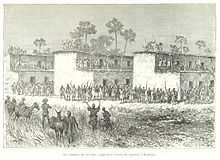
During the Middle Ages the Mossi established several separate kingdoms including those of Tenkodogo, Yatenga, Gourma, Zandoma, and Ouagadougou.[14] Sometime between 1328 and 1338 Mossi warriors raided Timbuktu but the Mossi were defeated by Sonni Ali of Songhai at the Battle of Kobi in Mali in 1483.[15]
During the early 16th century the Songhai conducted many slave raids into what is today Burkina Faso.[13] During the 18th century the Gwiriko Empire was established at Bobo Dioulasso and ethnic groups such as the Dyan, Lobi, and Birifor settled along the Black Volta.[16]
From colony to independence (1890s–1958)
Starting in the early 1890s a series of British, French and German military officers made attempts to claim parts of what is today Burkina Faso. At times these colonialists and their armies fought the local peoples; at times they forged alliances with them and made treaties. The colonialist officers and their home governments also made treaties amongst themselves. Through a complex series of events what is Burkina Faso eventually became a French protectorate in 1896.[17]
The eastern and western regions, where a standoff against the forces of the powerful ruler Samori Ture complicated the situation, came under French occupation in 1897. By 1898, the majority of the territory corresponding to Burkina Faso was nominally conquered; however, French control of many parts remained uncertain.
The Franco-British Convention of 14 June 1898 created the country's modern borders. In the French territory, a war of conquest against local communities and political powers continued for about five years. In 1904, the largely pacified territories of the Volta basin were integrated into the Upper Senegal and Niger colony of French West Africa as part of the reorganization of the French West African colonial empire. The colony had its capital in Bamako.
The French imposed their own language as the official one for colonial administration and generally appointed French colonists or nationals to prominent positions. The French started some schools and selected top students for additional education in France.
Draftees from the territory participated in the European fronts of World War I in the battalions of the Senegalese Rifles. Between 1915 and 1916, the districts in the western part of what is now Burkina Faso and the bordering eastern fringe of Mali became the stage of one of the most important armed oppositions to colonial government: the Volta-Bani War.[18]
The French government finally suppressed the movement but only after suffering defeats. It also had to organize its largest expeditionary force of its colonial history to send into the country to suppress the insurrection. Armed opposition wracked the Sahelian north when the Tuareg and allied groups of the Dori region ended their truce with the government.
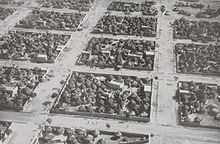
French Upper Volta was established on 1 March 1919. The French feared a recurrence of armed uprising and had related economic considerations. To bolster its administration, the colonial government separated the present territory of Burkina Faso from Upper Senegal and Niger.
The new colony was named Haute Volta, and François Charles Alexis Édouard Hesling became its first governor. Hesling initiated an ambitious road-making program to improve infrastructure and promoted the growth of cotton for export. The cotton policy – based on coercion – failed, and revenue generated by the colony stagnated. The colony was dismantled on 5 September 1932, being split between the French colonies of Côte d'Ivoire, French Sudan and Niger. Côte d'Ivoire received the largest share, which contained most of the population as well as the cities of Ouagadougou and Bobo-Dioulasso.
France reversed this change during the period of intense anti-colonial agitation that followed the end of World War II. On 4 September 1947, it revived the colony of Upper Volta, with its previous boundaries, as a part of the French Union. The French designated its colonies as departments of the metropole France on the European continent.
On 11 December 1958 the colony achieved self-government as the Republic of Upper Volta; it joined the Franco-African Community. A revision in the organization of French Overseas Territories had begun with the passage of the Basic Law (Loi Cadre) of 23 July 1956. This act was followed by reorganization measures approved by the French parliament early in 1957 to ensure a large degree of self-government for individual territories. Upper Volta became an autonomous republic in the French community on 11 December 1958. Full independence from France was received in 1960.[19]
Upper Volta (1958–1984)
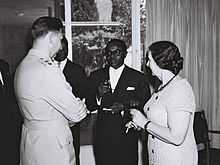
The Republic of Upper Volta (French: République de Haute-Volta) was established on 11 December 1958 as a self-governing colony within the French Community. The name Upper Volta related to the nation's location along the upper reaches of the Volta River. The river's three tributaries are called the Black, White and Red Volta. These were expressed in the three colors of the former national flag.
Before attaining autonomy, it had been French Upper Volta and part of the French Union. On 5 August 1960, it attained full independence from France. The first president, Maurice Yaméogo, was the leader of the Voltaic Democratic Union (UDV). The 1960 constitution provided for election by universal suffrage of a president and a national assembly for five-year terms. Soon after coming to power, Yaméogo banned all political parties other than the UDV. The government lasted until 1966. After much unrest, including mass demonstrations and strikes by students, labor unions, and civil servants, the military intervened.
The military coup d'état deposed Yaméogo, suspended the constitution, dissolved the National Assembly, and placed Lt. Col. Sangoulé Lamizana at the head of a government of senior army officers. The army remained in power for four years. On 14 June 1970, the Voltans ratified a new constitution that established a four-year transition period toward complete civilian rule. Lamizana remained in power throughout the 1970s as president of military or mixed civil-military governments. After conflict over the 1970 constitution, a new constitution was written and approved in 1977. Lamizana was reelected by open elections in 1978.
Lamizana's government faced problems with the country's traditionally powerful trade unions, and on 25 November 1980, Col. Saye Zerbo overthrew President Lamizana in a bloodless coup. Colonel Zerbo established the Military Committee of Recovery for National Progress as the supreme governmental authority, thus eradicating the 1977 constitution.
Colonel Zerbo also encountered resistance from trade unions and was overthrown two years later, on 7 November 1982, by Maj. Dr. Jean-Baptiste Ouédraogo and the Council of Popular Salvation (CSP). The CSP continued to ban political parties and organizations, yet promised a transition to civilian rule and a new constitution.
1983 coup d'état
Factional infighting developed between moderates in the CSP and the radicals, led by Capt. Thomas Sankara, who was appointed prime minister in January 1983. The internal political struggle and Sankara's leftist rhetoric led to his arrest and subsequent efforts to bring about his release, directed by Capt. Blaise Compaoré. This release effort resulted in yet another military coup d'état on 4 August 1983.
The coup brought Sankara to power and his government began to implement a series of "revolutionary" programs which included mass-vaccinations, infrastructure improvements, the expansion of women's rights, encouragement of domestic agricultural consumption, and anti-desertification projects.[20]
Burkina Faso (1984–)
On 4 August 1984,[19] as a result of President Sankara's activities, the country's name was changed from Upper Volta to Burkina Faso (land of the upright/honest people).[21][22][23]
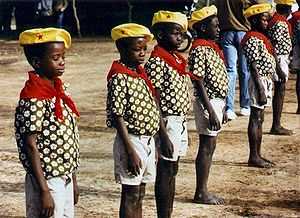
Sankara's government formed the National Council for the Revolution (CNR), with Sankara as its president, and established popular Committees for the Defense of the Revolution (CDRs) to "mobilize the masses" and implement the CNR's revolutionary programs. The regime created a youth program (the Pioneers of the Revolution) for indoctrinating children with Marxist ideals.[20] The government also armed and deputized CDR members who began a campaign to weed out suspected anti-revolutionaries, causing discontent amongst the country's population and increasing domestic opposition to Sankara's regime.[20]
Sankara's "revolution" took place within the context of the Cold War, and his visits to the Soviet Union and Cuba, calls for the cancellation of African debts held by Western governments and institutions and Marxist political regime were controversial [with whom?].
On 15 October 1987, Sankara along with twelve other officials were killed in a coup d'état organized by Blaise Compaoré, Sankara's former colleague and Burkina Faso's president until October 2014. After the coup and although Sankara was known to be dead, some CDRs mounted an armed resistance to the army for several days.
Deterioration in relations with neighbouring countries was one of the reasons given by Compaoré for the coup.[24] Compaoré argued that Sankara had jeopardised foreign relations with the former colonial power France and neighbouring Côte d'Ivoire (both of which supported the change in government). Following the coup Compaoré immediately reversed the nationalizations, overturned nearly all of Sankara's policies, returned the country back into the IMF fold, and ultimately spurned most of Sankara's legacy. Limited democratic reforms were introduced in 1990 by Compaoré. Under the new constitution, Compaoré was re-elected without opposition in 1991. In 1998 Compaoré won election in a landslide. In 2004 13 people were tried for plotting a coup against President Compaoré and the coup's alleged mastermind was sentenced to life imprisonment.[25] As of 2014, Burkina Faso remains one of the least developed countries in the world.
Compaoré's government has played the role of negotiator in several West-African disputes including the 2010–11 Ivorian crisis, the Inter-Togolese Dialogue, and the 2012 Malian Crisis.
Between February and April 2011, the death of a schoolboy provoked protests throughout the country, coupled with a military mutiny and a magistrates' strike.
October 2014 protests
Starting on 28 October 2014 protesters began to march and demonstrate in Ouagadougou against President Blaise Compaore who appeared ready to amend the constitution and extend his 27-year rule. On 30 October, some protesters set fire to the parliament[26] and took over the national TV headquarters.[27] Ouagadougou International Airport was closed and MPs suspended the vote on changing the constitution to allow Compaoré to stand for re-election in 2015. Later in the day, the military dissolved all government institutions and set a curfew.[28]
On 31 October 2014, President Compaoré, facing mounting pressure, resigned after 27 years in office.[29] Lt. Col. Isaac Zida said that he will lead the country during its transitional period before the planned 2015 presidential election but there are concerns over his close ties to the former president.[30] In November 2014 opposition parties, civil society groups and religious leaders adopted a plan for a transitional authority to guide Burkina Faso to elections.[31] Under the plan Michel Kafando was made the transitional President of Burkina Faso and Lt. Col. Zida became the acting Prime Minister and Defense Minister.
Government and politics
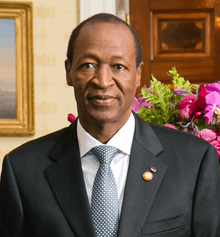
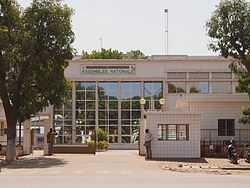
With French help, Blaise Compaoré seized power in a coup d'état in 1987. He overthrew his long-time friend and ally Thomas Sankara, who was killed in the coup.[32]
The constitution of 2 June 1991 established a semi-presidential government: its parliament can be dissolved by the President of the Republic, who is elected for a term of seven years. In 2000, the constitution was amended to reduce the presidential term to five years and set term limits to two, preventing successive re-election. The amendment took effect during the 2005 elections. If passed beforehand, it would have prevented Compaoré from being reelected.
Other presidential candidates challenged the election results. But in October 2005, the constitutional council ruled that, because Compaoré was the sitting president in 2000, the amendment would not apply to him until the end of his second term in office. This cleared the way for his candidacy in the 2005 election. On 13 November, Compaoré was reelected in a landslide, because of a divided political opposition.
In the 2010 Presidential elections, President Compaoré was re-elected. Only 1.6 million Burkinabés voted, out of a total population 10 times that size.
The 2011 Burkinabè protests were a series of popular protests that called for the resignation of Compaoré, democratic reforms, higher wages for troops and public servants and economic freedom.[33][34][35] As a result Governors were replaced and wages for public servants were raised.[36][37]
The parliament consists of one chamber known as the National Assembly which has 111 seats with members elected to serve five-year terms. There is also a constitutional chamber, composed of ten members, and an economic and social council whose roles are purely consultative. The 1991 constitution created a bicameral parliament but the upper house (Chamber of Representatives) was abolished in 2002.
The Compaoré administration has worked to decentralize power by devolving some of its powers to regions and municipal authorities. But the widespread distrust of politicians and lack of political involvement by many residents complicates this process. Critics describe this as a hybrid decentralisation.[38]
Political freedoms are severely restricted in Burkina Faso. Human rights organizations have criticised the Compaoré administration for numerous acts of state-sponsored violence against journalists and other politically active members of society.
Foreign relations
Burkina Faso is a member of the African Union, Community of Sahel-Saharan States, La Francophonie, Organisation of Islamic Cooperation, Economic Community of West African States, and United Nations.
Military
The army consists of some 6,000 men in voluntary service, augmented by a part-time national People's Militia composed of civilians between 25 and 35 years of age who are trained in both military and civil duties. According to Jane’s Sentinel Country Risk Assessment, Burkina Faso's Army is undermanned for its force structure and poorly equipped, but has wheeled light-armour vehicles, and may have developed useful combat expertise through interventions in Liberia and elsewhere in Africa.
In terms of training and equipment, the regular Army is believed to be neglected in relation to the élite Presidential Security Regiment (RSP). Reports have emerged in recent years of disputes over pay and conditions.[39] There is an air force with some 19 operational aircraft, but no navy, as the country is landlocked. Military expenses constitute approximately 1.2% of the nation’s GDP.
In April 2011, there was an army mutiny; the president named new chiefs of staff, and a curfew was imposed in Ouagadougou.[40]
Law enforcement
Burkina Faso employs numerous police and security forces, generally modeled after organizations used by French police. France continues to provide significant support and training to police forces. The Gendarmerie Nationale is organized along military lines, with most police services delivered at the brigade level. The Gendarmerie operates under the authority of the Minister of Defence, and its members are employed chiefly in the rural areas and along borders.[41]
There is a municipal police force controlled by the Ministry of Territorial Administration; a national police force controlled by the Ministry of Security; and an autonomous Regiment of Presidential Security (Régiment de la Sécurité Présidentielle, or RSP), a ‘palace guard’ devoted to the protection of the President of the Republic. Both the gendarmerie and the national police are subdivided into both administrative and judicial police functions; the former are detailed to protect public order and provide security, the latter are charged with criminal investigations.[41]
All foreigners and citizens are required to carry photo ID passports, or other forms of identification or risk a fine, and police spot identity checks are commonplace for persons traveling by auto, bush-taxi, or bus.[42][43]
Geography and climate
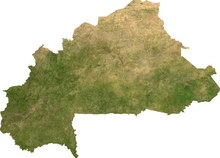
Geography
Burkina Faso lies mostly between latitudes 9° and 15°N (a small area is north of 15°), and longitudes 6°W and 3°E.
It is made up of two major types of countryside. The larger part of the country is covered by a peneplain, which forms a gently undulating landscape with, in some areas, a few isolated hills, the last vestiges of a Precambrian massif. The southwest of the country, on the other hand, forms a sandstone massif, where the highest peak, Ténakourou, is found at an elevation of 749 meters (2,457 ft). The massif is bordered by sheer cliffs up to 150 m (492 ft) high. The average altitude of Burkina Faso is 400 m (1,312 ft) and the difference between the highest and lowest terrain is no greater than 600 m (1,969 ft). Burkina Faso is therefore a relatively flat country.
The country owes its former name of Upper Volta to three rivers which cross it: the Black Volta (or Mouhoun), the White Volta (Nakambé) and the Red Volta (Nazinon). The Black Volta is one of the country's only two rivers which flow year-round, the other being the Komoé, which flows to the southwest. The basin of the Niger River also drains 27% of the country's surface.
The Niger's tributaries – the Béli, the Gorouol, the Goudébo and the Dargol – are seasonal streams and flow for only four to six months a year. They still can flood and overflow, however. The country also contains numerous lakes – the principal ones are Tingrela, Bam and Dem. The country contains large ponds, as well, such as Oursi, Béli, Yomboli and Markoye. Water shortages are often a problem, especially in the north of the country.
Administrative divisions
The country is divided into 13 administrative regions. These regions encompass 45 provinces and 301 departments. Each region is administered by a Governor.
Climate
Burkina Faso has a primarily tropical climate with two very distinct seasons. In the rainy season, the country receives between 600 and 900 mm (23.6 and 35.4 in) of rainfall; in the dry season, the harmattan – a hot dry wind from the Sahara – blows. The rainy season lasts approximately four months, May/June to September, and is shorter in the north of the country. Three climatic zones can be defined: the Sahel, the Sudan-Sahel, and the Sudan-Guinea. The Sahel in the north typically receives less than 600 mm (23.6 in)[44] of rainfall per year and has high temperatures, 5–47 °C (41.0–116.6 °F).
A relatively dry tropical savanna, the Sahel extends beyond the borders of Burkina Faso, from the Horn of Africa to the Atlantic Ocean, and borders the Sahara to its north and the fertile region of the Sudan to the South. Situated between 11°3' and 13°5' north latitude, the Sudan-Sahel region is a transitional zone with regards to rainfall and temperature. Further to the south, the Sudan-Guinea zone receives more than 900 mm (35.4 in)[44] of rain each year and has cooler average temperatures.
Burkina Faso's natural resources include manganese, limestone, marble, phosphates, pumice, salt and small deposits of gold.
Wildlife and the environment
Burkina Faso has a larger number of elephants than many countries in West Africa. Lions, leopards and buffalo can also be found here, including the dwarf or red buffalo, a smaller reddish-brown animal which looks like a fierce kind of short-legged cow. Other large predators live in Burkina Faso, such as the cheetah, the caracal or African lynx, the spotted hyena and the African wild dog, one of the continent’s most endangered species.[45]
Burkina Faso's fauna and flora are protected in four national parks:
- The W National Park in the east which passes Burkina Faso, Benin, and Niger
- The Arly Wildlife Reserve (Arly National Park in the east)
- The Léraba -Comoé Classified Forest and Partial Reserve of Wildlife in the west
- The Mare aux Hippopotames in the west
and several reserves: see List of national parks in Africa, Nature reserves of Burkina Faso.
Economy
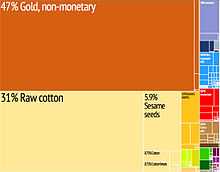
The value of Burkina Faso's exports fell from $2.77 billion in 2011 to $754 million in 2012.[46] Agriculture represents 32% of its gross domestic product and occupies 80% of the working population. It consists mostly of rearing livestock. Especially in the south and southwest, the people grow crops of sorghum, pearl millet, maize (corn), peanuts, rice and cotton, with surpluses to be sold. A large part of the economic activity of the country is funded by international aid.
Burkina Faso was ranked the 111th safest investment destination in the world in the March 2011 Euromoney Country Risk rankings.[47] Remittances used to be an important source of income to Burkina Faso until the 1990s, when unrest in Côte d'Ivoire, the main destination for Burkinabe emigrants, forced many to return home. Remittances now account for less than 1% of GDP.
Burkina Faso is part of the West African Monetary and Economic Union (UMEOA) and has adopted the CFA Franc. This is issued by the Central Bank of the West African States (BCEAO), situated in Dakar, Senegal. The BCEAO manages the monetary and reserve policy of the member states, and provides regulation and oversight of financial sector and banking activity. A legal framework regarding licensing, bank activities, organizational and capital requirements, inspections and sanctions (all applicable to all countries of the Union) is in place, having been reformed significantly in 1999. Micro-finance institutions are governed by a separate law, which regulates micro-finance activities in all WAEMU countries. The insurance sector is regulated through the Inter-African Conference on Insurance Markets (CIMA).[48]

There is mining of copper, iron, manganese, gold, cassiterite (tin ore), and phosphates.[49] These operations provide employment and generate international aid. Gold production increased 32% in 2011 at six gold mine sites, making Burkina Faso the fourth-largest gold producer in Africa, after South Africa, Mali and Ghana.[50]
Burkina Faso also hosts the International Art and Craft Fair, Ouagadougou. It is better known by its French name as SIAO, Le Salon International de l' Artisanat de Ouagadougou, and is one of the most important African handicraft fairs.
Burkina Faso is a member of the Organization for the Harmonization of Business Law in Africa (OHADA).[51]
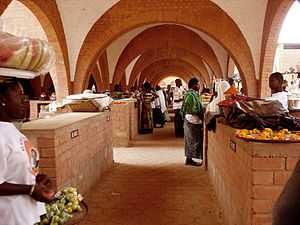
While services remain underdeveloped, the National Office for Water and Sanitation (ONEA), a state-owned utility company run along commercial lines, is emerging as one of the best-performing utility companies in Africa, .[52] High levels of autonomy and a skilled and dedicated management has driven ONEA's ability to improve production of and access to clean water.[52]
Since 2000, nearly 2 million more people have access to water in the four principal urban centres in the country; the company has kept the quality of infrastructure high (less than 18% of the water is lost through leaks – one of the lowest in sub-Saharan Africa), improved financial reporting, and increased its annual revenue by an average of 12% (well above inflation).[52] Challenges remain, including difficulties among some customers in paying for services, with the need to rely on international aid to expand its infrastructure.[52] The state-owned, commercially run venture has helped the nation reach its Millennium Development Goal (MDG) targets in water-related areas, and has grown as a viable company.[52]
The growth rate in Burkina Faso is high although it continues to be plagued by corruption and incursions from terrorist groups from Mali and Niger.[53]
Transport
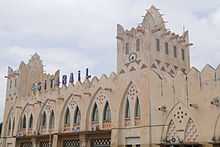
Transport in Burkina Faso is hampered by a largely underdeveloped infrastructure.
The main airport is at Ouagadougou and as of June 2014 it had regularly scheduled flights to many destinations in West Africa as well as Paris, Brussels and Istanbul. There is another international airport at Bobo Dioulasso which has flights to Ouagadougou and Abidjan.
Rail transport in Burkina Faso consists of a single line which runs from Kaya to Abidjan in Côte d'Ivoire via Ouagadougou, Koudougou, Bobo Dioulasso and Banfora. Sitarail operates a passenger train three times a week along the route.[54]
There are 12,506 kilometres of highway in Burkina Faso, of which 2,001 kilometres are paved.
Society
Demographics
.jpg)
Burkina Faso is an ethnically integrated, secular state. Most of Burkina's people are concentrated in the south and center of the country, where their density sometimes exceeds 48 per square kilometer (125/sq. mi.). Hundreds of thousands of Burkinabe migrate regularly to Côte d'Ivoire and Ghana, mainly for seasonal agricultural work. These flows of workers are affected by external events; the September 2002 coup attempt in Côte d'Ivoire and the ensuing fighting meant that hundreds of thousands of Burkinabe returned to Burkina Faso. The regional economy suffered when they were unable to work.[55]
The total fertility rate of Burkina Faso is 5.93 children born per woman (2014 estimates), the sixth highest in the world.[56]
In 2009 the U.S. Department of State's Trafficking in Persons Report reported that slavery in Burkina Faso continued to exist and that Burkinabè children were often the victims.[57] Slavery in the Sahel states in general, is an entrenched institution with a long history that dates back to the Arab slave trade.[58]
Ethnic groups
Burkina Faso's 17.3 million people belong to two major West African ethnic cultural groups—the Voltaic and the Mande (whose common language is Dioula). The Voltaic Mossi make up about one-half of the population. The Mossi claim descent from warriors who migrated to present-day Burkina Faso from the area of Ghana Empire about 1100. They established an empire that lasted more than 800 years. Predominantly farmers, the Mossi kingdom is led by the Mogho Naba, whose court is in Ouagadougou.[55]
Languages
Burkina Faso is a multilingual country. An estimated 69 languages are spoken there,[59] of which about 60 are indigenous. The Mossi language (Mossi: Mòoré) is spoken by about 40% of the population, mainly in the central region around the capital, Ouagadougou, along with other, closely related Gurunsi languages scattered throughout Burkina.
In the west, Mande languages are widely spoken, the most predominant being Dyula (also known as Jula or Dioula), others including Bobo, Samo, and Marka. The Fula language (Fula: Fulfulde, French: Peuhl) is widespread, particularly in the north. The Gourmanché language is spoken in the east, while the Bissa language is spoken in the south.
The official language is French, which was introduced during the colonial period. French is the principal language of administrative, political and judicial institutions, public services, and the press. It is the only language for laws, administration and courts.
Religion

Statistics on religion in Burkina Faso are inexact because Islam and Christianity are often practiced in tandem with indigenous religious beliefs. The Government of Burkina Faso 2006 census reported that 60.5% of the population practice Islam, and that the majority of this group belong to the Sunni branch,[60][61] while a small minority adheres to Shia Islam. There are also large concentrations of the Ahmadiyya Muslims.[62]
A significant number of Sunni Muslims identify with the Tijaniyah Sufi order. The government estimated that 23.2% of the population are Christians (19% being Roman Catholics and 4.2% members of Protestant denominations); 15.3% follow traditional indigenous beliefs, 0.6% have other religions, and 0.4% have none (atheism is virtually nonexistent).[60][61]
A popular saying in Burkina Faso claims that "50% are Muslim, 50% are Christian, and 100% are animist". This shows the wide level of acceptance of the religions amongst each other. Muslims and Christians also value ancient animist rites. The Great Mosque of Bobo-Dioulasso was built by people of different faiths working together.
Health
In 2012, the average life expectancy was estimated at 57 for male and 59 for female. The under five mortality rate and the infant mortality rate were respectively 102 and 66 per 1000 live births.[63] In 2014, the median age of its inhabitants is 17 and the estimated population growth rate is 3.05%.[56]
In 2011, health expenditures was 6.5% of GDP; the maternal mortality ratio was estimated at 300 deaths per 100000 live births and the physician density at 0.05/1000 population in 2010. In 2012, it was estimated that the adult HIV prevalence rate (ages 15–49) was 1.0%.[64] According to the 2011 UNAIDS Report, HIV prevalence is declining among pregnant women who attend antenatal clinics.[65] According to a 2005 World Health Organization report, an estimated 72.5% of Burkina Faso's girls and women have suffered female genital mutilation, administered according to traditional rituals.[66]
Central government spending on health was 3% in 2001.[67] As of 2009, studies estimated there were as few as 10 physicians per 100,000 people.[68] In addition, there were 41 nurses and 13 midwives per 100,000 people.[68] Demographic and Health Surveys has completed three surveys in Burkina Faso since 1993, and had another in 2009.[69]
Education
Education in Burkina Faso is divided into primary, secondary and higher education.[70] High school costs approximately CFA 25,000 ($50 USD) per year, which is far above the means of most Burkinabè families. Boys receive preference in schooling; as such, girls' education and literacy rates are far lower than their male counterparts. An increase in girls' schooling has been observed because of the government's policy of making school cheaper for girls and granting them more scholarships.
To proceed from elementary to middle school, middle to high school or high school to college, national exams must be passed. Institutions of higher education include the University of Ouagadougou, The Polytechnic University of Bobo-Dioulasso, and the University of Koudougou, which is also a teacher training institution. There are some small private colleges in the capital city of Ouagadougou but these are affordable to only a small portion of the population.
There is also the International School of Ouagadougou (ISO), an American-based private school located in Ouagadougou.
The 2008 UN Development Program Report ranked Burkina Faso as the country with the lowest level of literacy in the world, despite a concerted effort to double its literacy rate from 12.8% in 1990 to 25.3% in 2008.[71]
Culture
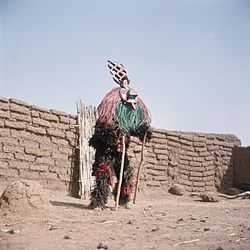
Literature in Burkina Faso is based on the oral tradition, which remains important. In 1934, during French occupation, Dim-Dolobsom Ouedraogo published his Maximes, pensées et devinettes mossi (Maximes, Thoughts and Riddles of the Mossi), a record of the oral history of the Mossi people.[72]
The oral tradition continued to have an influence on Burkinabè writers in the post-independence Burkina Faso of the 1960s, such as Nazi Boni and Roger Nikiema.[73] The 1960s saw a growth in the number of playwrights being published.[72] Since the 1970s, literature has developed in Burkina Faso with many more writers being published.[74]
The theatre of Burkina Faso combines traditional Burkinabè performance with the colonial influences and post-colonial efforts to educate rural people to produce a distinctive national theatre. Traditional ritual ceremonies of the many ethnic groups in Burkina Faso have long involved dancing with masks. Western-style theatre became common during colonial times, heavily influenced by French theatre. With independence came a new style of theatre inspired by forum theatre aimed at educating and entertaining Burkina Faso's rural people.
Arts and crafts
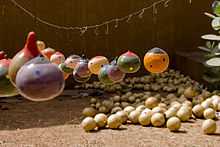
In addition to several rich traditional artistic heritages among the peoples, there is a large artist community in Burkina Faso, especially in Ouagadougou. Much of the crafts produced are for the growing tourist industry.
Cuisine
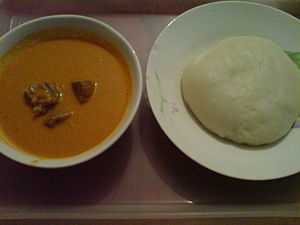
Typical of West African cuisine, Burkina Faso's cuisine is based on staple foods of sorghum, millet, rice, maize, peanuts, potatoes, beans, yams and okra.[75] The most common sources of animal protein are chicken, chicken eggs and fresh water fish. A typical Burkinabè beverage is Banji or Palm Wine, which is fermented palm sap and Zoom-kom[?].
Cinema
The cinema of Burkina Faso is an important part of West African and African film industry.[76] Burkina's contribution to African cinema started with the establishment of the film festival FESPACO (Festival Panafricain du Cinéma et de la Télévision de Ouagadougou), which was launched as a film week in 1969. Many of the nation's filmmakers are known internationally and have won international prizes.
For many years the headquarters of the Federation of Panafrican Filmmakers (FEPACI) was in Ouagadougou, rescued in 1983 from a period of moribund inactivity by the enthusiastic support and funding of President Sankara. (In 2006 the Secretariat of FEPACI moved to South Africa, but the headquarters of the organization is still in Ouagaoudougou.) Among the best known directors from Burkina Faso are Gaston Kaboré, Idrissa Ouedraogo and Dani Kouyate.[77] Burkina produces popular television series such as Bobodjiouf. The internationally known filmmakers such as Ouedraogo, Kabore, Yameogo, and Kouyate make popular television series.
Sports
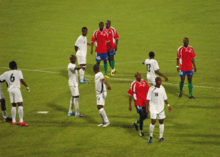
Sport in Burkina Faso is widespread and includes football (soccer), basketball, cycling, Rugby union, handball, tennis, athletics, boxing and martial arts. Football is very popular in Burkina Faso, played both professionally, and informally in towns and villages across the country. The national team is nicknamed "Les Etalons" ("the Stallions") in reference to the legendary horse of Princess Yennenga.
In 1998, Burkina Faso hosted the Africa Cup of Nations for which the Omnisport Stadium in Bobo-Dioulasso was built. In 2013, Burkina Faso qualified for the African Cup of Nations in South Africa, reached the final, but then lost to Nigeria by the score of 0 to 1. The country is currently ranked 71st in the FIFA World Rankings.[78]
Media
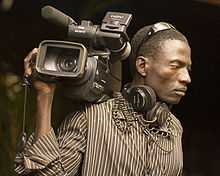
The nation's principal media outlet is its state-sponsored combined television and radio service, Radiodiffusion-Télévision Burkina (RTB).[79] RTB broadcasts on two medium-wave (AM) and several FM frequencies. Besides RTB, there are privately owned sports, cultural, music, and religious FM radio stations. RTB maintains a worldwide short-wave news broadcast (Radio Nationale Burkina) in the French language from the capital at Ouagadougou using a 100 kW transmitter on 4.815 and 5.030 MHz.[80]
Attempts to develop an independent press and media in Burkina Faso have been intermittent. In 1998, investigative journalist Norbert Zongo, his brother Ernest, his driver, and another man were assassinated by unknown assailants, and the bodies burned. The crime was never solved.[81] However, an independent Commission of Inquiry later concluded that Norbert Zongo was killed for political reasons because of his investigative work into the death of David Ouedraogo, a chauffeur who worked for François Compaoré, President Blaise Compaoré's brother.[82][83]
In January 1999, François Compaoré was charged with the murder of David Ouedraogo, who had died as a result of torture in January 1998. The charges were later dropped by a military tribunal after an appeal. In August 2000, five members of the President's personal security guard detail (Régiment de la Sécurité Présidentielle, or RSP) were charged with the murder of Ouedraogo. RSP members Marcel Kafando, Edmond Koama, and Ousseini Yaro, investigated as suspects in the Norbert Zongo assassination, were convicted in the Ouedraogo case and sentenced to lengthy prison terms.[82][83]
Since the death of Norbert Zongo, several protests regarding the Zongo investigation and treatment of journalists have been prevented or dispersed by government police and security forces. In April 2007, popular radio reggae host Karim Sama, whose programs feature reggae songs interspersed with critical commentary on alleged government injustice and corruption, received several death threats.[84]
Sama's personal car was later burned outside the private radio station Ouaga FM by unknown vandals.[85] In response, the Committee to Protect Journalists (CPJ) wrote to President Compaoré to request his government investigate the sending of e-mailed death threats to journalists and radio commentators in Burkina Faso who were critical of the government.[81] In December 2008, police in Ouagadougou questioned leaders of a protest march that called for a renewed investigation into the unsolved Zongo assassination. Among the marchers was Jean-Claude Meda, the president of the Association of Journalists of Burkina Faso.[86]
See also
- Holidays in Burkina Faso
- Index of Burkina Faso-related articles
- List of cities in Burkina Faso
- Music of Burkina Faso
- Outline of Burkina Faso
- Tourism in Burkina Faso
- Transport in Burkina Faso
References
- ↑ 1.0 1.1 "Burkina Faso population projection". insd.bf (in French). 2014. Retrieved 1 October 2014.
- ↑ 2.0 2.1 "Burkina Faso". International Monetary Fund. Retrieved 1 October 2014.
- ↑ 3.0 3.1 "Burkina Faso". International Monetary Fund. Retrieved 1 October 2014.
- ↑ "Distribution of family income – Gini index". The World Factbook. CIA. Retrieved 1 September 2009.
- ↑ "2014 Human Development Report Summary" (PDF). United Nations Development Programme. 2014. pp. 21–25. Retrieved 27 July 2014.
- ↑ CFA Franc BCEAO. Codes: XOF / 952 ISO 4217 currency names and code elements. ISO.
- ↑ Tens of thousands attend Burkina Faso protest, Protesters voice opposition to referendum that would allow Blaise Campaore to extend his presidential term, Reuters, Last updated: 1 June 2014 01:34.
- ↑ Violent Protests Topple Government in Burkina Faso, BBC.
- ↑ UNESCO World Heritage Centre. "Site archéologique de Bura". unesco.org.
- ↑ Miller, D. E.; Van Der Merwe, N. J. (2009). "Early Metal Working in Sub-Saharan Africa: A Review of Recent Research". The Journal of African History 35: 1–36. doi:10.1017/S0021853700025949. JSTOR 182719.
- ↑ Stuiver, Minze; van der Merwe, Nicolaas J. (1968). "Radiocarbon Chronology of the Iron Age in Sub-Saharan Africa". Current Anthropology 9 (1): 54–58. JSTOR 2740446.
- ↑ Rupley, p. 27
- ↑ 13.0 13.1 Rupley, p. 28
- ↑ "Encyclopedia of the Nations." History. Advameg, Inc., n.d. Web. 8 October 2014.
- ↑ Rupley, p. xxvioi
- ↑ Rupley, p. xxvix
- ↑ Rupley, pp. 30–33
- ↑ Mahir Saul and Patrick Royer, West African Challenge to Empire, 2001
- ↑ 19.0 19.1 "More (Language of the Mossi Tribe) Phrase Book". World Digital Library. Retrieved 16 February 2013.
- ↑ 20.0 20.1 20.2 Sankara, Thomas The Upright Man, (video), youtube,
- ↑ Kingfisher Geography Encyclopedia. ISBN 1-85613-582-9. Page 170
- ↑ Manning, Patrick (1988). Francophone Sub-Saharan Africa: 1880-198. Cambridge: New York.
- ↑ The name is an amalgam of More burkina ("honest", "upright", or "incorruptible men") and Jula faso ("homeland"; literally "father's house"). The "-be" suffix in the name for the people – Burkinabe – comes from the Fula plural suffix for people, -ɓe.
- ↑ Kasuka, Bridgette (2011). African Leaders. 3rd Paragraph: Bankole Kamara Taylor. p. 13. ISBN 978-1468114362. Retrieved 30 October 2014.
- ↑ "Burkina Faso Profile." Burkina Faso Profile. BBC NEWS AFRICA, 21 March 2014. Web. 24 September 2014.
- ↑ "BBC News – Burkina Faso parliament set ablaze". BBC News. Retrieved 30 October 2014.
- ↑ "Burkina Faso protesters set parliament on fire, take over state TV and march on presidency". The Sydney Morning Herald. Retrieved 30 October 2014.
- ↑ Gongo, Simon and Bax, Pauline. "Burkina Faso General Takes Power After President Resigns". Businessweek.com.
- ↑ Herve, Taoko and Cowelloct, Alan (31 October 2014) Burkina Faso’s President Resigns, and General Takes Reins. New York Times.
- ↑ "BBC News – Army backs new Burkina Faso leader Isaac Zida". BBC News.
- ↑ "Burkina Faso talks agree on plan for return to civilian rule". Reuters. Retrieved 9 November 2014.
- ↑ "Burkina Faso's Blaise Compaore sacks his government", BBC News, 15 April 2011
- ↑ "Burkina opposition calls anti-president demo". The Daily Star. 23 April 2011. Retrieved 24 April 2011.
- ↑ Taoko, Hervé; Nossiter, Adam (27 April 2011). "Mayor’s Home Burned as Burkina Faso Protests Continue". The New York Times. Archived from the original on 29 April 2011. Retrieved 30 April 2011.
- ↑ Gongo, Simon (28 April 2011). "Burkina Faso Riot Police Join Wave of Protests After Government Dissolved". Bloomberg L.P. Retrieved 30 April 2011.
- ↑ "Burkina Faso teachers' strike: Union agrees deal". BBC News. 25 May 2011. Archived from the original on 27 May 2011. Retrieved 28 May 2011.
- ↑ "Burkina Faso government replaces its governors". Taiwan News. 9 June 2011. Retrieved 11 June 2011.
- ↑ Tiendrebeongo, Aristide (March 2013). "Failure Likely". dandc.eu.
- ↑ Jane's Sentinel Security Assessment – West Africa, 15 April 2009
- ↑ "Burkina Faso capital under curfew after army mutiny". BBC News. 16 April 2011. Retrieved 17 April 2011.
- ↑ 41.0 41.1 Das, Dilip K. and Palmiotto, Michael J. (2005) World Police Encyclopedia, Routledge, ISBN 0-415-94250-0. pp. 139–141
- ↑ U.S. Dept. of State, Burkina Faso: Country Specific Information
- ↑ Foreign and Commonwealth Office, Sub-Saharan Africa: Burkina Faso at the Wayback Machine (archived 27 August 2009). fco.gov.uk
- ↑ 44.0 44.1 "SIM Country Profile: Burkina Faso". Archived from the original on 9 March 2008. Retrieved 5 August 2006.
- ↑ Geography & Wildlife. our-africa.org
- ↑ "OEC: Products exported by Bulgaria (2012)". The Observatory of Economic Complexity. Retrieved 30 October 2014.
- ↑ "Euromoney Country Risk". Euromoney Country Risk. Euromoney Institutional Investor PLC. Retrieved 15 August 2011.
- ↑ Burkina Faso Financial Sector Profile at the Wayback Machine (archived 16 December 2013), MFW4A
- ↑ Profile – Burkina Faso. Inadev.org. Retrieved on 5 April 2014.
- ↑ York, Jeoffrey (15 April 2012). "Iamgold's growing investment in Burkina Faso". The Globe and Mail (Toronto).
- ↑ "OHADA.com: The business law portal in Africa". Retrieved 22 March 2009.
- ↑ 52.0 52.1 52.2 52.3 52.4 Peter Newborne 2011. Pipes and People: Progress in Water Supply in Burkina Faso's Cities, London: Overseas Development Institute
- ↑ "Burkina Faso". Retrieved 17 October 2014.
- ↑ European Rail Timetable, Summer 2014 Edition
- ↑ 55.0 55.1 "Burkina Faso", U.S. Department of State, June 2008.
 This article incorporates text from this source, which is in the public domain.
This article incorporates text from this source, which is in the public domain. - ↑ 56.0 56.1 Burkina Faso. CIA World Factbook
- ↑ June 2009 the U.S. Department of State Trafficking in Persons Report, http://gvnet.com/humantrafficking/BurkinaFaso-2.htm
- ↑ "West Africa slavery still widespread". BBC News. 27 October 2008.
- ↑ Lewis, M. Paul (ed.), 2009. Ethnologue: Languages of the World, Sixteenth edition. Dallas, Tex.: SIL International. (Page on "Languages of Burkina Faso.")
- ↑ 60.0 60.1 Comité national du recensement (July 2008). "Recensement général de la population et de l'habitation de 2006". Conseil national de la statistique. Archived from the original (PDF) on 2011-04-21. Retrieved 20 January 2011.
- ↑ 61.0 61.1 International Religious Freedom Report 2010: Burkina Faso. United States Bureau of Democracy, Human Rights and Labor (17 November 2010). This article incorporates text from this source, which is in the public domain.
- ↑ Breach of Faith. Human Rights Watch. June 2005. p. 8. Retrieved 4 June 2014.
Estimates of around 20 million would be appropriate
- ↑ "Statistics in Burkina Faso". World Health Organization.
- ↑ UN AIDS: HIV/AIDS – adult prevalence rate. Retrieved on 25 July 2014.
- ↑ UNAIDS World AIDS Day Report 2011 (PDF), UNAIDS, retrieved 29 March 2012
- ↑ Female genital mutilation and other harmful practices, WHI.int
- ↑ "Globalis – an interactive world map – Burkina Faso – Central government expenditures on health". Globalis.gvu.unu.edu. Archived from the original on 16 May 2011. Retrieved 1 October 2009.
- ↑ 68.0 68.1 "WHO Country Offices in the WHO African Region – WHO | Regional Office for Africa". Afro.who.int. Retrieved 20 June 2010.
- ↑ Burkina Faso DHS Surveys, measuredhs.com
- ↑ "Education – Burkina Faso". Nationsencyclopedia.com. Retrieved 1 October 2009.
- ↑ UNDP Human Development Report 2007/2008 at the Wayback Machine (archived 29 April 2011). Palgrave Macmillan. 2007. ISBN 978-0-230-54704-9
- ↑ 72.0 72.1 Salhi, Kamal (1999). Francophone Voices. Intellect Books. p. 37. ISBN 1-902454-03-0. Retrieved 26 April 2014.
- ↑ Allan, Tuzyline Jita (1997). Women's Studies Quarterly: Teaching African Literatures in a Global Literary. Feminist Press. p. 86. ISBN 1-55861-169-X. Retrieved 26 April 2014.
- ↑ Marchais, Julien (2006). Burkina Faso (in French). Petit Futé. pp. 91–92. ISBN 2-7469-1601-0. Retrieved 26 April 2014.
- ↑ "Oxfam's Cool Planet – Food in Burkina Faso". Oxfam. Archived from the original on 17 May 2012. Retrieved 21 May 2008.
- ↑ Spaas, Lieve (2000) "Burkina Faso," in The Francophone Film: A Struggle for Identity, pp. 232–246. Manchester: Manchester University Press, ISBN 0719058619.
- ↑ Turégano, Teresa Hoefert (2005) African Cinema and Europe: Close-Up on Burkina Faso, Florence: European Press Academic, ISBN 888398031X.
- ↑ "The FIFA/Coca-Cola World Ranking". FIFA.com. Retrieved 10 July 2013.
- ↑ "Radiodiffusion-Télévision Burkina". Rtb.bf. Retrieved 1 October 2009.
- ↑ Radio Station World, Burkina Faso: Governmental Broadcasting Agencies
- ↑ 81.0 81.1 Committee to Protect Journalists, Burkina Faso
- ↑ 82.0 82.1 Reporters Sans Frontieres, What’s Happening About The Inquiry Into Norbert Zongo’s Death?
- ↑ 83.0 83.1 Reporters Sans Frontieres, Outrageous Denial Of Justice 21 July 2006
- ↑ IFEX, Radio Station Temporarily Pulls Programme After Host Receives Death Threats, 26 April 2007
- ↑ FreeMuse.org, Death threat against Reggae Radio Host, 3 May 2007
- ↑ Keita, Mohamed, Burkina Faso Police Question Zongo Protesters, Committee to Protect Journalists, 15 December 2008
Bibliography
- Rupley, Lawrence; Bangali, Lamissa and Diamitani, Boureima (2013). Historical Dictionary of Burkina Faso. The Scarecrow Press. ISBN 978-0-8108-6770-3.
Further reading
- Engberg-Perderson, Lars, Endangering Development: Politics, Projects, and Environment in Burkina Faso (Praeger Publishers, 2003).
- Englebert, Pierre, Burkina Faso: Unsteady Statehood in West Africa (Perseus, 1999).
- Howorth, Chris, Rebuilding the Local Landscape: Environmental Management in Burkina Faso (Ashgate, 1999).
- McFarland, Daniel Miles and Rupley, Lawrence A, Historical Dictionary of Burkina Faso (Scarecrow Press, 1998).
- Manson, Katrina and Knight, James, Burkina Faso (Bradt Travel Guides, 2011).
- Roy, Christopher D and Wheelock, Thomas G B, Land of the Flying Masks: Art and Culture in Burkina Faso: The Thomas G.B. Wheelock Collection (Prestel Publishing, 2007).
- Sankara, Thomas, Thomas Sankara Speaks: The Burkina Faso Revolution 1983–1987 (Pathfinder Press, 2007).
- Sankara, Thomas, We are the Heirs of the World's Revolutions: Speeches from the Burkina Faso Revolution 1983–1987 (Pathfinder Press, 2007).
External links
- (French) Premier Ministère, official government portal.
- Burkina Faso entry at The World Factbook
- LeFaso.net, a news information site.
- Burkina Faso from UCB Libraries GovPubs.
- Burkina Faso at DMOZ
- Burkina Faso profile from the BBC News.
 Wikimedia Atlas of Burkina Faso
Wikimedia Atlas of Burkina Faso- News headline links from AllAfrica.com.
- Overseas Development Institute
- Country profile at New Internationalist.
- Key Development Forecasts for Burkina Faso from International Futures.
- Trade
| |||||||||||||||||||||||||||||||||||||||||
| |||||||||||||||||||||||||||||||||||||||||||||||||||||||||||||||||||||||||||||||||||||||||||||||||||||||||||||||||||||||||||||||||||||||||||||||||||||||||||||

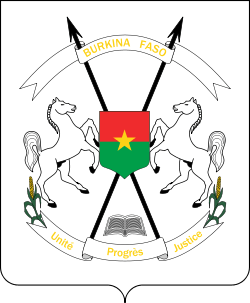
.svg.png)
.svg.png)
